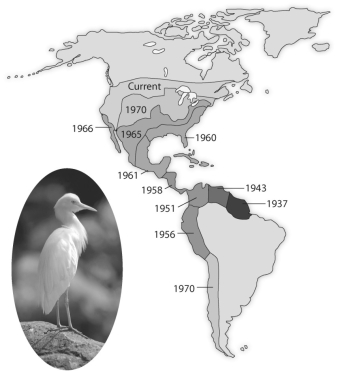Multiple Choice
Use the following diagram from the text showing the spread of the cattle egret, Bulbulcus ibis, since its arrival in the New World, to answer the following question.

Figure 52.1
-Air masses formed over the Pacific Ocean are moved by prevailing westerlies where they encounter extensive north-south mountain ranges, such as the Sierra Nevada and the Cascades. Which statement best describes the changes that these air masses undergo?
A) The cool, moist Pacific air heats up as it rises, releasing its precipitation as it passes the tops of the mountains, and this warm, now dry air cools as it descends on the leeward side of the range.
B) The warm, moist Pacific air rises and cools, releasing precipitation as it moves up the windward side of the range, and this cool, now dry air mass heats up as it descends on the leeward side of the range.
C) The cool, dry Pacific air heats and picks up moisture from evaporation of the snowcapped peaks of the mountain range, releasing this moisture as precipitation as the air cools as it descends on the leeward side of the range.
D) These air masses are blocked by these mountain ranges producing high annual amounts of precipitation on the windward sides of these mountain ranges.
E) These air masses remain essentially unchanged in moisture content and temperature as they pass over these mountain ranges.
Correct Answer:

Verified
Correct Answer:
Verified
Q22: You are working for the Environmental Protection
Q22: Which of the following biomes is correctly
Q23: Use the following diagram from the text
Q24: Which of the following events might you
Q27: You are planning a dive in a
Q28: Which of the following is responsible for
Q29: Use the following diagram from the text
Q38: Which of the following are important biotic
Q42: Which of the following areas of study
Q57: Studying species transplants is a way that